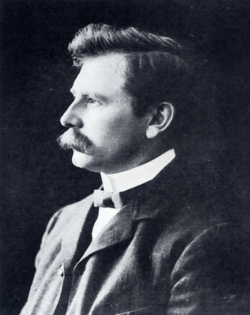 |
Anton van Wouw ( gebore 20 November 1862, Driebergen (Nederland)- sterf 30 Julie 1945, Pretoria) was 'n Nederlands-gebore beeldhouer en word beskou as die vader die beeldhoukunste in Suid-Afrika. Van Wouw was ook die pleegpa van die bekende skilder, Jacobus Hendrik Pierneef.
Van Wouw het op 28 jarige ouderdom (1880) besluit om na die onwikkelende stad van Pretoria te trek en wag vir tien jaar vir sy eerste beelhou kontrak. Die kom toe van die finansier, Sammy Marks om die Krugerstandbeeld ter ere van oud-president Paul Kruger te ontwerp wat vandag nog in Kerkplein, Pretoria staan.
In sy werk vang hy gereeld die rowwe en emosionele kern van sy onderwerp vas. Een van sy belangrikste werke is die figuur van 'n vrou wat deel uitmaak van die Vrouemonument naby Bloemfontein. Hy het saam met Frans Soff gewerk in die skep van die figuur. Hy het ook die minder geslaagde figuur van 'n vrou gemaak wat deel is van die Voortrekkermonument in Pretoria, 'n borsbeeld van Generaal Christiaan de Wet en die standbeeld van Louis Botha in Durban. |
Anton van Wouw |
|
Hy het ook verskeie kleiner beelde gemaak van inheemse mense. Hulle is baie minder formeel as sy groter werk met treffende lewensgetroue gesigsuitdrukkings.
Van Wouw ontvang in 1936 'n eredoktorsgraad van die Universiteit van Pretoria en in 1937 die SA Akademie Medalje vir Beeldhou.
Sy woonhuis, in Brooklyn, Oostelike Pretoria, (ontwerp deur Norman Eaton in 1939) word geopen as 'n museum deur die Universiteit van Pretoria in 1974.
| Anton van Wouw (1862-1945) |
Anton van Wouw was born in Driebergen, near Utrecht in the Netherlands on 26 December 1862. He had a thorough training in academic sculpture in Europe, initially through evening classes at the Rotterdam Academie under the guidance of the Flemish architect and artist, Vieillevoye, but later also in the studio of the Belgian sculptor, Joseph Graven (1836-1877). During his student days he undertook visits to Brussels and Paris to view the galleries there. The experience which he gained early in his life as a stucco-worker had a definite influence on his preference for the art of modelling.
Van Wouw and his mother came to South Africa on 1 January 1890, in the hope that he was going to make his fortune as a sculptor here. The discovery of gold on the Witwatersrand, the great increase in permanent building projects in Johannesburg, which Van Wouw had most certainly heard of, and the numerous letters to his family from his father and older brother in Pretoria where they had been employed in government posts since 1882, without any doubt strengthened Anton van Wouw's decision to emigrate to the Boer Republic of Transvaal. His father, who was Inspector of Offices under the State Secretary, Dr Leyds, wanted Anton to become involved in the booming building trade in the Transvaal Republic. Since Van Wouw had been trained as a stucco-modeller and concrete caster in Holland, he probably envisaged that he would easily obtain numerous architectural and sculptural commissions from local architects.
However, to his disappointment he soon discovered that there was little work for a professional sculptor in Pretoria at that time. He initially found temporary work in Pretoria as an assistant in a gun shop owned by a Mr H C Miolee, but spent his evenings making drawings and small sculptures.
After six months in the gun shop, the young sculptor decided that he would try to make it on his own and rather devote all his time to his art. He advertised his services as an ornamental sculptor in a local newspaper and obtained a commission from the well-known Pretoria businessman, E F Bourke, to decorate the living room of his new house in Pretoria with painting and stucco-work. This commission led to Van Wouw's first public commission, namely the sculpting of the old Republican coat-of-arms on the pediment of the ’new’ Raadsaal on Church Square in Pretoria. He thus met a number of prominent architects in Pretoria and Johannesburg, who eventually supplied him with numerous architectural commissions. It is known that Van Wouw made sculptural stucco panels for the Old Standard Bank building on Church Square and that this building was designed by Emley and Scott in 1894.
On 3 February 1895 Van Wouw married Suzanna Wilhelmina (Sannie) Celliers, a sister of the poet Jan F E Celliers. Two daughters were born from this union. In April of that year Van Wouw applied for naturalisation so that he could give art lessons at the Staatsmodelskool and the Staatsmeisjeskool in order to have a fixed income. He worked there until October 1896 when he received written confirmation from the well-known Pretoria businessman, Sammy Marks, to proceed with the sculpting of a statue of President Paul Kruger for Pretoria.
Eventually he left for Italy to make the large monument in Rome. It was here that Van Wouw's first wife, Sannie, died of pneumonia. |
| text from http://web.up.ac.za/default.asp?ipkCategoryID=10465&sub=1&parentid=5885&subid=10318&ipklookid=14 visted 20 November 2010 |
At that time Van Wouw identified very closely with the nationalist struggle of the Afrikaner, with the result that he was commissioned to make eight large monuments in the then Union of South Africa. Amongst these are the Women’s Memorial in Bloemfontein, the ’Onze Jan’ Statue in Cape Town, Louis Botha in Durban, Andrew Murray in Cape Town, President Steyn in Bloemfontein, General Lukin in Cape Town and the Voortrekker Woman and Children in Pretoria. Amongst his best known monumental busts are President M W Pretorius (1905), Judge J Leonard (1911), Dr E P Jorissen (1914), ’Onze Jan Hofmeyr’ (1916), President F W Reitz (1919), J X Merriman (1919), King Khama (1925), General C R de Wet (1926), General Koos de la Rey (1926), Mussolini (1927), Klisser Bernardt (1927), Dr David Draper (1928), General H T Lukin (1930), Dr J S P Stewart (1930), Professor A. Moorrees (1933), Cor Delfos (1935), Judge J W Wessels (1937), Adolf Hitler (1937), Piet Retief (1937), President M T Steyn 1938), General Manie Maritz (1940) and also larger relief panels in Pretoria, Boksburg, Johannesburg and Dundee.
Although he will always be remembered for these larger monuments, it is his smaller statuettes, which show greater aesthetic quality and value. Many of these were made in his studio in Doornfontein in Johannesburg, where he moved in 1906. These statuettes include The Bushman Hunter, Kruger in Exile, Bad News, Nôtjie van die Onderveld, Skapu Player, Dagga Smoker, Shangaan, Sleeping African, Basutu Witness, Hunter Drinking, Mieliepap Eater, Laughing Basutu, and Coffee Drinker.
In 1939, he moved back to Pretoria and settled in Brooklyn in the home designed for him by the well-known architect Norman Eaton. Van Wouw moved into the house in January 1939 with his second wife, whom he married in 1917. He lived and worked there until his death on 30 June 1945.
| Vrou en kinders, voltooi in 1938. Die brons beeld wat die rol vereer wat die vrou gespeel het tydens die Groot Trek was van Wouw se laaste opdrag. Die beeld teen die voet van die Voortrekkermonument in Pretoria staan 4.1 meter hoog en weeg 2.5 ton. Die gietwerk is gedoen deur Renzo Vignali in Pretoria. Die modelle vir die standbeeld was Isabel Snyman as die vrou, Betty Wolk as die dogter en Joseph Goldstein as die seun. |
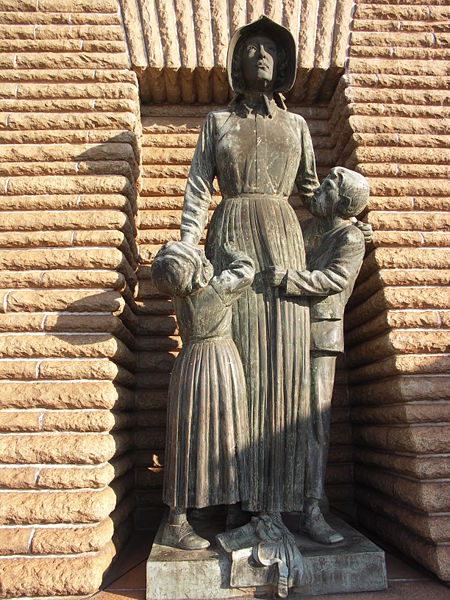 |
The Kruger statue, together with the four additional Boer figures, was completed in Rome in 1898 and they were all cast in bronze early in 1899. The sculptures were shipped to Delagoa Bay (vandag Port Elizabeth), but because of the Anglo-Boer War they had to remain in a warehouse of the African Boating Company in Lourenço Marques (Maputo) until after the war. Sammy Marks, who had to pay the storage costs of the sculptures, gave the four Boer figures to Lord Kitchener when he heard from him that permission to erect the monument in Pretoria would never be granted, and the statue of Kruger remained in the warehouse until the war ended. It was only much later, in 1913, that the Kruger statue, without its four Boer figures, was erected in Prinsepark in Pretoria.
In 1925 the complete monument was placed in front of the Pretoria Railway station and in 1954 it was finally moved to its present position on Church Square. This monument was really the start of Van Wouw’s career as a sculptor in South Africa. |
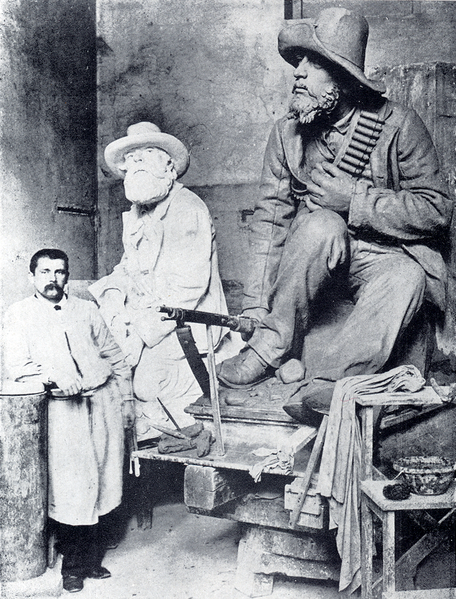 |
| |
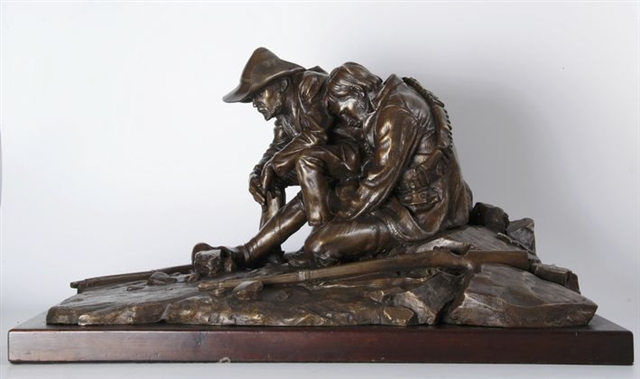 |
| |
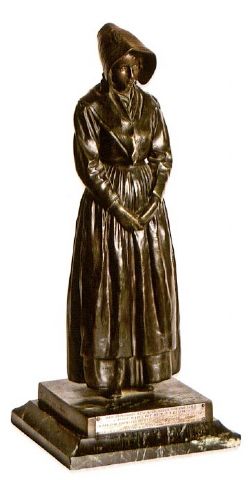 |
African Studies by Anton van Wouw
When Anton van Wouw arrived in South Africa from the Netherlands, he was 28 years old. Here he met the indigenous people of the country for the first time. His rendering of Africans shows a perceptual awareness. Not only does Van Wouw show the anatomical characteristics of the African, but he created these studies of the indigenous people with dignity and understanding. Spirit and culture come to the fore in these works.
Van Wouw modelled from life and his subjects are shown in different moods and situations. A serene and pensive mood is evident in his bronze sculpture entitled The Thinker (1935). With his chin resting on his hand, the subject seems unaware of the world around him, lost in his own thoughts.
A happy and joyful mood is created in the bronze work Laughing Basutu (1936). With his arms folded over his chest and head turned to the right, the subject seems happy and lively. The play of light on the features adds to the liveliness of the work.
In the bronze work Shangaan (1907) we see a reserved person. He looks slightly down, the brow is furrowed and arms tightly crossed over his chest as if he is cutting himself off from the onlooker.
In Sleeping African of 1907, the subject is totally relaxed, fast asleep with mouth open and head slightly tilted to the right. The arms are lightly folded. In contrast to this work, Shangaan seems tense and worried.
Calmness, serenity and almost a regal element are present in Zulu (1907). A striking contrast is evident in the texture of hair and beard, as well as the smooth skin. The man seems undisturbed by trivialities. He looks ahead with eyes cast slightly down, proud to be a Zulu.
Van Wouw created the African in his everyday activities as seen in The Hammer Worker (1911). The worker is busy hammering at a rock and is almost encircled by rock. The figure seems to ‘grow’ out of the rock. Skapu Player (1907) shows the African in a seated position relaxing while he plays his music. Mieliepap Eater (1907) shows the African preparing his food in a typical pose. He sits stirring his food in the three-legged pot. The Hunter Drinking (1907) shows the lithe body as nature’s child. The same horizontal composition is present in Dagga Smoker (1907). With dignity and respect, Van Wouw sculptured King Khama, head of the Bamangwatu. The wise old man stares ahead with tired eyes. Old age and experience are evident in this work of Van Wouw. The model for Bushman Hunter was well known to Van Wouw. He actually worked for Van Wouw who studied his build and movements. Van Wouw often played bow and arrow games with him. His understanding of the small Bushman is quite evident in this work.
The studies of indigenous people by Van Wouw include:
· Bushman Hunter (bronze) 1902
· Sleeping African (bronze) 1907
· Hunter drinking (bronze) 1907
· Coffee Drinker (Sidwane Tokozile) (bronze) 1907
· Zulu (bronze) 1907
· Basutu Witness (bronze) 1907
· Mieliepap Eater (bronze) 1907
· Shangaan (bronze) 1907
· Skapu Player (bronze) 1907
· Dagga Smoker (bronze) 1907
· The Hammer Worker (bronze) 1911
· King Khama (bronze) 1925
· Laughing Basutu (bronze) 1936
· The Thinker (bronze) 1937
History of the Van Wouw House
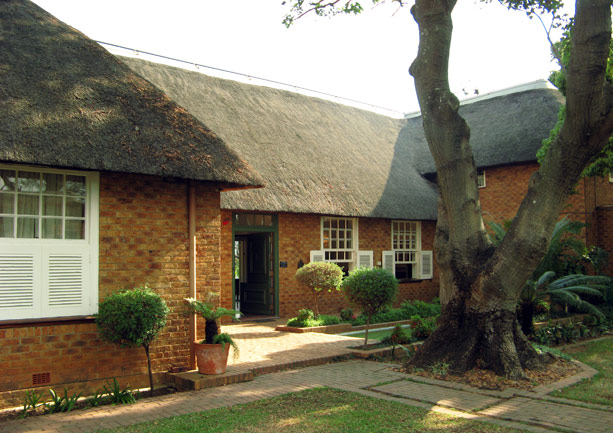 The Van Wouw House, now the property of the University of Pretoria, was the last home and studio of the sculptor Anton van Wouw (1862-1945). The stand on which the house was built initially belonged to a Mr J Brookes. The stand changed ownership three times and was sold to Van Wouw in 1937. He commissioned the architect Norman Eaton to build a house for him on the southern erf. The Van Wouw House, which was completed in 1938, shows the personal style that Norman Eaton had already developed at the time. The house was designed both as residence and studio. The unity between the building and the environment is conspicuous. Van Wouw was a great lover of nature and a keen gardener and commissioned Eaton to design a residence with an affinity between architecture and nature.
The Van Wouw House, now the property of the University of Pretoria, was the last home and studio of the sculptor Anton van Wouw (1862-1945). The stand on which the house was built initially belonged to a Mr J Brookes. The stand changed ownership three times and was sold to Van Wouw in 1937. He commissioned the architect Norman Eaton to build a house for him on the southern erf. The Van Wouw House, which was completed in 1938, shows the personal style that Norman Eaton had already developed at the time. The house was designed both as residence and studio. The unity between the building and the environment is conspicuous. Van Wouw was a great lover of nature and a keen gardener and commissioned Eaton to design a residence with an affinity between architecture and nature.
An ornamental pool, and later on a lush garden, contributed to this link between home and nature. The house itself was built with face brick, has a thatch roof and wooden window frames with shutters. Terracotta tiles and wooden floors add further to its charm.
The sound of water in the fishpond, climbing plants and lush gardens link the dwelling to the surrounding landscape. From the large south-facing veranda, one has a lovely view to the south.
Van Wouw moved into his new home early in 1939 and lived there until his death on 30 June 1945. Professor and Mrs S F Oosthuizen of the University of Pretoria then occupied the house until 1973.
During the 25th Annual General Meeting of the Rembrandt Group on 16 November 1973, Dr Anton Rupert announced that a sum of money equal to the selling price of the property had been given to the University of Pretoria to purchase the Van Wouw House. Through this gesture, this valuable and exceptional house became the property of the University. Dr Rupert officially handed over the house to the University on 21 May 1974.






